November 19, 2010
Air Date: November 19, 2010
FULL SHOW
SEGMENTS
FDA Puts Transgenic Fish on the Scales
View the page for this story
The first genetically modified animal for human consumption could soon be on its way to a dinner table near you. The Food and Drug Administration is set to make a decision about the safety of transgenic salmon. Some, including Dr. Martin Smith, an economist at Duke University, say the FDA is ignoring potential effects on both human and environmental health. He talks with host Bruce Gellerman. (05:40)
Congressional Fight Over CO2
/ Jeff YoungView the page for this story
The Environmental Protection Agency will start regulating greenhouse gases from some of the country's biggest sources in January. With the death of climate change legislation in Congress, EPA's use of the Clean Air Act is one of the few tools the Obama administration has left to address global warming pollution. But in a showdown on Capitol Hill, some lawmakers aim to block EPA from taking action. Living on Earth’s Jeff Young reports on what’s at stake. (06:15)
Cool Fix for a Hot Planet- NYC Blues
/ Honah LilesView the page for this story
With a wastewater system that is over a century old, New York City is losing the battle against overflow contamination of the East and Hudson Rivers. As Living on Earth’s Honah Liles reports, the city’s mayor is proposing to add a new weapon to the fight: blue and green roofs. (02:00)
New Era, New Curriculum
/ Ingrid LobetView the page for this story
Many Americans are re-evaluating their relationship with chemicals, asking where they end up in people and the environment once they've fulfilled their intended use. Now universities are teaching students to ask those same questions. Ingrid Lobet reports on changes at UC Berkeley. (15:35)
Lead Surprisingly Still in Brass Plumbing
View the page for this story
In response to taste complaints, officials at the University of North Carolina at Chapel Hill tested water in the college’s brand new buildings. To their surprise they found lead in the water. Host Bruce Gellerman talks with Marc Edwards, a civil engineering professor from Virginia Tech University. Edwards was called in to find out where the lead was coming from and how to remediate the problem. (06:30)
The Legend of Pale Male
View the page for this story
New York is known as a city of strangers. But that changed when a redtailed hawk made his home on the ledge of one of Fifth Avenue’s ritziest buildings. People from all walks of life flocked to a bench in Central Park to view the trials and tribulations of the bird named Pale Male, forging a bond and a new community. Frederic Lilien was one of Pale Male’s followers. He tells host Bruce Gellerman about the hawk, the city, and the love story which he documented in his feature-length film “The Legend of Pale Male.” (09:00)
This week's EarthEar selection
listen /
download
A tidal wetland on the Hudson River Estuary.
Show Credits and Funders
Show Transcript
HOST: Bruce Gellerman
GUESTS: Martin Smith, Marc Edwards, Frederic Lilien
REPORTERS: Jeff Young, Ingrid Lobet
NOTE: Honah Liles
[THEME]
GELLERMAN: From Public Radio International, this is Living on Earth. I’m Bruce Gellerman. As the FDA weighs the safety of the first genetically modified fish, an expert weighs the agency process that could land the fish on your dish.
SMITH: I am working on a book called “Should I Eat Fish?” And I don’t have an answer to that question- a yes or no answer to that question.
GELLERMAN: Also, the head of the EPA says small businesses have nothing to fear from greenhouse gas regulations.
JACKSON: It is a myth. EPA will regulate cows, dunkin’ donuts, pizza huts, your lawn mower, someone said to me today kittens—I like that one (laughter). It is not true.
GELLERMAN: And a bird of prey soars above New York and inspires a city.
FISHER: To see a father hawk, a mother hawk, bring a rat to his baby.... it's wonderful. It's biblical.
GELLERMAN: A hawk, a city, a love story, and more on Living on Earth. Don’t fly away.
[THEME]
FDA Puts Transgenic Fish on the Scales
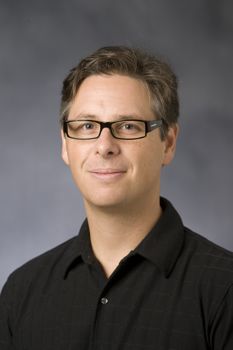
Dr. Martin Smith, associate professor of environmental economics at Duke, is co-author of a recent paper critiquing the FDA’s review process of the first genetically modified animal for human consumption. (Duke University)
GELLERMAN: From the Jennifer and Ted Stanley Studios in Somerville, Massachusetts, this is Living on Earth. I’m Bruce Gellerman. The first genetically modified animal for human consumption could soon be on its way to a dinner plate near you. Any day now, the Food and Drug Administration is set to make a decision about the safety of a transgenic fish called the AquaAdvantage Salmon. It’s designed to grow about twice as fast as your usual salmon. But there are some who have a beef with the process the FDA is using to evaluate the fish. Among them is Martin Smith, an economist at Duke University.

Dr. Martin Smith, associate professor of environmental economics at Duke, is co-author of a recent paper critiquing the FDA’s review process of the first genetically modified animal for human consumption. (Duke University)
SMITH: So the concern is that the FDA is looking at this decision in an overly narrow way. They’re treating the decision about whether to approve this genetically modified salmon as if one salmon is just going to replace another salmon. But what they’re ignoring is, that with technological innovations like this, the purpose of them is to lower production costs. And, in all likelihood that will lead to expanding production, and that, in turn, may lower prices and change to total amount of salmon that people are eating.
GELLERMAN: So, the FDA is looking at this fish based upon its impact on human health and environmental safety. What are some of the larger impacts that you see?
SMITH: On the human health side, the larger impacts are quite striking. If you grow the salmon market significantly, you may have people eating more salmon and less of other animal proteins. That could have very, very significant positive public health impacts because salmon is a particularly healthy food. So, that of course, would weigh in favor of approving this product. On the negative side, if you grow the market substantially, you look at environmental impacts. One of the problems with salmon is that the technology still requires feeding salmon feed that comes from wild fish stocks. Some of those wild fish stocks are not managed well. And, so, if you grow the salmon market, you might exacerbate pressure on wild fish stocks that are poorly managed.
GELLERMAN: What about fish farmers vs. fishermen-- that is, people who raise fish in pens or people who hook them in nets or on lines?
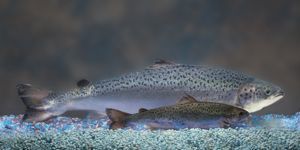
The genetically modified AquaAdvantage salmon (background) dwarfs an Atlantic salmon of the same age. (AquaBounty)
SMITH: In this particular case, this is an interesting one, because the company plans deliberately to grow this product in tank-based systems. But, there are connections between the capture fishery for salmon and farmed salmon- the prices move together. These products don’t exist completely independently in the market. So, if you lower prices by expanding the farmed salmon market, those lower prices are going to affect fishermen.
GELLERMAN: So, what would you suggest in terms of the FDA’s process? What should they be doing?
SMITH: What we suggest is that the FDA should think about the various scenarios in which this product will affect markets. And look at those scenarios and trace through both the human health impacts, which as I mentioned could be very positive, because of the health benefits of eating salmon, but that they also look at some of these environmental consequences.
GELLERMAN: This could be an exquisitely complex problem. How do you measure society benefits vs. environmental costs, health costs, impacts down the road- how do you do that?
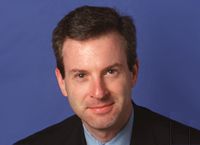
Jonathan Wiener, a professor at Duke Law School, co-author of the recent paper in Science. (Duke Law School)
SMITH: Well it is exquisitely complex process as you put it. In economics, we try to create a common metric for everything- so we try to monetize benefits and costs and put them together and see which ones are bigger. And, not all public policy decisions should be made solely on the basis of benefit/cost analysis, but it’s worth doing that analysis to at least inform those decisions. Even if the FDA takes the broader analysis that we suggest, they may ultimately come to the same decision about this particular case that they would looking at it narrowly. So, the issue here is process. And, we’re at a crossroads here. We have an opportunity here to set the right precedent, because we’re considering the first transgenic animal for human consumption.
GELLERMAN: I’m wondering if the FDA is institutionally capable of making this kind of decision.
SMITH: That is a very difficult question. FDA certainly has economists working for it, and so they have some capacity to do it. We argue in our paper that Congress should give them additional funding to build infrastructure to do this kind of analysis.
GELLERMAN: Oy! Then you’d have to factor in politics into your equation.
SMITH: (Laughs) I’m pretty sure politics are already involved.
GELLERMAN: Professor Smith, I’ve gotta ask you- would you eat transgenic fish?
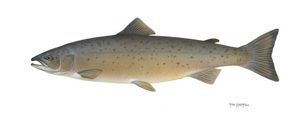
A drawing of an Atlantic Salmon in the wild. (Drawing: Timothy Knepp)
SMITH: Uh, that’s a great question. I am working on a book called “Should I Eat Fish?” and I don’t have an answer to that question- a yes or no answer to that question, but I would lean toward yes on this particular example.
GELLERMAN: Because, you’re putting the FDA in a spot here with your paper. You’re saying, you know, ‘what do we do, what do we do, kind of, as a society?’ And, I’m standing in the supermarket thinking before the fishmonger, and I’ve gotta decide, do I eat that fish or not?
SMITH: Absolutely. I think what we do is we make decision deliberately. We weigh all the benefits and the costs. That’s what we’re asking the FDA to do- to make that as transparent as possible.
GELLERMAN: Well, Professor Smith, thank you very much!
SMITH: Thank you.
GELLERMAN: Martin Smith is an economist at Duke University. His analysis of the FDA review process of the first transgenic fish appears in the latest issue of Science.
[MUSIC: Marco Benevento “Numbers” from Between The Needles And Nightfall (Royal Potato Family 2010)]
Related links:
- AquaBounty
- Future Food: Frankenfish
Congressional Fight Over CO2

(Roger Smith)
GELLERMAN: Come early January, the U.S. Environmental Protection Agency will take a major step toward restricting greenhouse gases. The agency will begin regulating emissions from large stationary sources, such as power plants, major refineries and chemical facilities. That is, unless, Congress says no. A growing contingent of lawmakers wants to stop or delay the EPA’s greenhouse gas rules. Living on Earth’s Jeff Young explains what’s at stake.
YOUNG: For the past few weeks the most pressing matter for Alaska Senator Lisa Murkowski has been spelling. She still faces a legal challenge from her opponent, but it looks like Sen. Murkowski has waged the first successful write-in campaign for Senate since 1954. Alaskans, it turns out, can spell her name.
MURKOWSKI: We did have a pictogram. It was M-U-R +, and then a picture of a cow with a K on the cow’s belly, and then a pair of skis. So, we were reminding people that, look, this is not that difficult.
YOUNG: Now Senator Murkowski can return to another pressing matter: spelling out for the EPA what it should and should not do about global warming. She’s the top Republican on the Senate’s energy committee. This summer Senator Murkowski got 47 votes –far short of the 60 needed
—for a senate resolution that would have stripped EPA of its authority to regulate greenhouse gases. She pledges to try again.
MURKOWSKI: What we fear is the inclusion of not just the largest emitters, but the gym down by my neighborhood or the dry cleaner, the facilities you have in your neighborhood.
YOUNG: In 2007 the Supreme Court ruled EPA must consider carbon dioxide a pollutant under the Clean Air Act. For most pollutants, the act requires regulation for any source of 250 tons or more a year. But because CO2 is such a different kind of pollutant, EPA took a different approach. It will only apply the regulations to facilities that emit at least 75 thousand tons of CO2. But Senator Murkowski doubts that will stand in the courts.
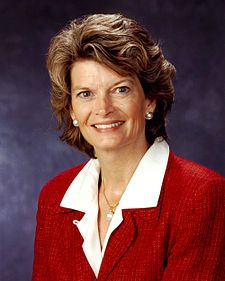
Senator Lisa Murkowski (R/ AK)
MURKOWSKI: You’re gonna have the first law suit that says, ‘no wait a minute, the Clean Air Act says anything over 250 tons,’ and so then EPA is gonna be forced to regulate them. So, even though administrator may say, look, this is not our intent, under the Clean Air Act, that’s kinda where you’re stuck.
YOUNG: EPA administrator Lisa Jackson has tried to assure Congress and the business community that Senator Murkowski’s scenario of regulations for mom-and-pop stores won’t come to pass. Here’s what Jackson told a gathering at Georgetown Law School last year:
JACKSON: There is this myth—it is a myth—EPA will regulate cows, dunkin’ donuts, pizza huts, your lawn mower, someone said to me kittens-- I like that one. And, it’s overzealous and somehow misguided, and somehow, you know, strange unfurling of regulatory might that will happen any second now because nobody is putting the breaks on EPA. It is not true.
YOUNG: But the rhetoric against Jackson’s agency is heating up as the start date for the new rules approaches. Industry representatives warn of a possible halt to new plant construction and economic havoc as state agencies become overwhelmed trying to deal with new CO2 permits. Bill Becker has a one-word answer for all that:
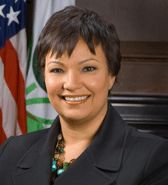
Administrator of the Environmental Protection Agency, Lisa Jackson. (EPA)
BECKER: “Baloney.”
YOUNG: Becker leads the National Association of Clean Air Agencies. His members are the ones who actually do most of the work writing Clean Air Act permits at the state level. Becker says state agencies are well prepared for the new greenhouse gas rules. And EPA’s guidelines mean that most facilities will simply need to improve efficiency in order to reduce emissions.
BECKER: If you listen to industry, they’d have you believe that they’re going to be asked to do some things that are impossible, that’s going to shut them down. And the fact of the matter is all states are primed, except for one, to start this program and the kinds of actions that state and local permitting authorities will be asking industry to do are smart, sensible, energy efficiency ones.
YOUNG: Texas is the only state refusing to participate in the greenhouse gas program. But several states joined Texas in suing EPA over the new rules, and challenges in Congress are almost certain. Republican leaders pledge to use control of the House to investigate EPA’s actions. And they’ll get support from Democrats from the more fossil fuel dependent states. West Virginia Democratic Senator Jay Rockefeller is pushing a proposal to delay any EPA action by two years. The president has pledged to veto any such attempts. But Professor Robert Stavins at Harvard’s Kennedy School of government says it adds up to some tricky politics for EPA.

(Roger Smith)
STAVINS: The EPA is right in the middle, and some people would say they’re trying to walk a knife-edge here.
YOUNG: Stavins says EPA risks alienating conservative Democrats and empowering Republicans who want to paint the administration as anti-business. On the other hand, the EPA rules are crucial, both to reduce emissions and to give the president concrete action he can point to in international climate talks. And Stavins adds, this is not a position the administration wanted to be in.
STAVINS: Everyone in administration, from the president on down has said that the preferred way to address climate change is with Congressional action. But, if that wasn’t there, then they were obligated, as they would say, to go the regulatory route. So, that was a threat. Well, you know, the bluff, you could say has been called. This is something they’re not particularly eager, in my opinion, to go forward with.
YOUNG: Stavins says the coming year will be a test of the agency’s commitment and creativity when it comes to using an old law to take on a new challenge. For Living on Earth, I’m Jeff Young.
GELLERMAN: You can hear Jeff’s full interview with Sen Murkowski at our website, L-O-E dot org.
Related links:
- EPA explains its regulatory approach to greenhouse gases
- A report on state clean air agencies preparedness to carry out greenhouse gas permits
[MUSIC: Orgone “Watch It” from Killon Floor (Ubiquity Records 2007).]
GELLERMAN: Just ahead: a formula for green chemistry. Keep listening to Living on Earth!
[CUTAWAY MUSIC: Arthur Lipner: “Morning Song” from Brazilian Vibes (Mallet Works Media).]
Cool Fix for a Hot Planet- NYC Blues
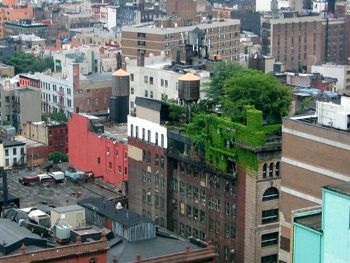
NYC's green roofs. (Wikipedia Creative Commons)
GELLERMAN: It’s Living on Earth, I’m Bruce Gellerman. Coming up – a science sleuth solves the mysterious case of lead in campus water coolers. But first, this Cool Fix for a Hot Planet from Honah Liles.
[COOL FIX THEME]
LILES: New York City is about to get the blues—blue roofs that is. Under a new plan proposed by Mayor Michael Bloomberg, the city hopes to combat storm water runoff by using blue and green roofs.
New York’s wastewater system is over a century old. Storm water and municipal sewage are funneled into the same pipes, and these days, the volume sometimes exceeds the capacity of the wastewater treatment plants. When it does, the wastewater overflows into the East and Hudson Rivers.

NYC’s green roofs. (Photo: Wikipedia Creative Commons)
Blue and green roofs capture rainfall, and allow it to be gradually released over time. To do this, blue roofs use drainage pools while green roofs grow ivy or grass. And covering the city in these roofs will do more than reduce sewage overflow into the rivers. The vegetation and gardens on green roofs harbor diverse species of insects, fungi and plants, while also promoting food production. They could even help lower the city’s ambient temperature in the summer. The water collected on blue roofs can be recycled and used for irrigation and sidewalk cleaning.
New York aims to reduce wastewater overflow 40 percent by the year 2030. Perhaps the colorful roofs will earn the city a new nickname—the Big Green Apple. That’s this week’s Cool Fix for a Hot Planet. I’m Honah Liles.
GELLERMAN: And if you have a Cool Fix for a Hot Planet, we'd like to know it. If we use your idea on the air, we'll send you a shiny blue Living on Earth tire gauge. Keeping your tires properly inflated can save you big bucks in fuel.
Call our listener line at 800-218-9988, that's
800-218-99-88. Or email coolfix – that's one word – coolfix at L-O-E dot org, or post it at our Facebook page – PRI’s Living on Earth.
And remember, you can hear our program anytime on our website, L-O-E dot org or get a download for your MP3 player.
There you’ll also find pictures and more information about our stories. And we’d like to hear from you: You can reach us at comments @ L-O-E dot org. Once again, comments @ L-O-E dot O-R-G.
Related links:
- Mayor Bloomberg’s PlaNYC
- PS 118 Pilot Study: Green vs. Blue roofs
New Era, New Curriculum
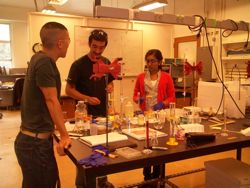
Second year students Michael Poon, Max Babicz and Swetha Akella help refine one of the new green lab experiments. (Photo: Ingrid Lobet)
GELLERMAN: For more than 60 years the chemical company DuPont promised, “Better things for better living through chemistry”. Well, these days the slogan might say: “better chemistry for better living.”
In laboratories across the country chemists are trying to come up with new formulas to make safer products. And students at many universities are learning how to do it. It’s called green chemistry. Living On Earth’s Ingrid Lobet reports on the changes at one of the nation’s most influential chemistry departments: the University of California, Berkeley.
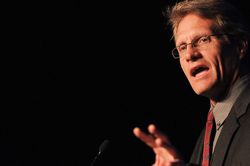
Environmental Health Researcher Dr. Michael Wilson (UC Berkeley)
[SOUNDS OF AN AUTO REPAIR SHOP, TORQUE WRENCH]
LOBET: Two blocks from the UC Berkeley campus, Michael Wilson stands outside a garage.
WILSON: So, we’re at a very typical automotive repair shop. We have about six or eight mechanics working here with vehicles on hydraulic jacks and as you can see this is a fairly solvent-intensive process.
LOBET: Wilson is a professor of public health now, but eight years ago he was a fire fighter-paramedic, studying for his PhD here in environmental health, when he heard about the case of an injured worker.
WILSON: A young man, a 24-year old automotive mechanic, with really advanced symptoms of neurological disease. He had lost his sensory and motor function in his limbs. He had at lost his grip strength; he was in a wheelchair.
LOBET: The state health department had a hunch about what was happening to this young man.
WILSON: He was going through about eight to ten cans a days of a commercially available, break-cleaning solvent product that was formulated with hexane and acetone. And that formulation causes nerve damage.
LOBET: Wilson wondered whether this was an isolated case, so he started visiting other auto repair shops. He found 14 more mechanics with similar neurological damage just in the Bay Area. They would spray the cleaning solvent on cars, then work while the vapor evaporated, as Wilson put it, in their breathing zone.
[SOUNDS OF TOOLS DROPPING]
LOBET: This toxic brake cleaner wasn’t something that had been around for years and somehow escaped the attention of California regulators. It was a new product. California officials had asked manufacturers to remove some of the hexane from their cleaner because it can turn into ozone, which burns people’s lungs and aggravates asthma. They did. And replaced it with acetone.
WILSON: Why is it that a known neurotoxic solvent was used under completely uncontrolled conditions by workers across the state of California?

A typical fume hood. Some departments are remodeling their labs with fewer of these hoods. (Photo: Ingrid Lobet)
[SOUND OF THE BERKLEY BELL TOWER]
LOBET: On campus, Mike Wilson says, he found himself in the precarious position of wanting to change a profession he was just entering.
WILSON: Our field has typically been about measuring the extent of the damage, and I became interested in the next level of question which was: Why are we creating these occupational and environmental health hazards in the first place? Don’t we have the have the talent and the resources to create safer chemicals and safer products from the beginning?
LOBET: These questions led Wilson to the field of green chemistry. Established by Paul Anastas and John Warner in the 1990s, it’s the emerging field that looks at where chemicals end up in people and the environment, and advocates safer substances. Next, Wilson began talking with the university chemistry department.
WILSON: What we found here at the Berkeley campus was that chemistry education hadn’t really changed much in the last 30-40 years.
LOBET: Not too long after, Wilson met a new chemistry grad student who’d arrived at the university. Marty Mulvihill and Mike Wilson had something in common—call it a public interest approach.
MULVIHILL: While I was here, it was really important to me not only that I do research, but that I reach out to my community and think about the ways that chemists specifically could influence society. Like, we use a lot of resources from society—chemistry is a very resource intensive thing—like, how do we give back?
LOBET: With this kind of community orientation it was natural that the first thing Mulvihill did when he got to Berkeley was start organizing other chemistry grad students.
MULVIHILL: The name of that group was actually Chemists for Peace, which turned out to be far too controversial for a place like Berkeley. I mean, there’s like that perception that Berkeley is an activist-oriented thing, but when you look at chemistry, anything that even appears political is not widely accepted.
So, we produced a lot of coffee mugs, people generally liked that we were around, but it never really took hold.
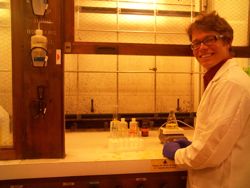
Dr. Marty Mulvihill stands at a traditional hood. Some school are trying to reduce the need for vapor hoods by using more benign substances. (Photo: Ingrid Lobet)
LOBET: It dawned on Mulvihill that he needed to be speaking science to scientists. So he and a core of other grad students organized their own seminar series.
They got a grant from the Dow chemical company, and brought in top thinkers in green chemistry: John Warner, Paul Anastas, Terry Collins. At first Mulvihill says, the Chemistry department wouldn’t even give them a room to meet in, but gradually the students prevailed.
MULVIHILL: I can remember the evening it happened. The dean had just come in. I think it was his first, maybe his second year. The graduate seminar was going on and John Warner, one of the fathers, one of the guys who wrote the original book on green chemistry, had agreed to come to campus and give a talk. And the Dean actually showed up to that talk. Not only show up for the talk, but he came out to dinner afterwards, and it was so fun to watch as the Dean and John Warner, so it’s Dean Rich Mathies and John Warner interacted and all of a sudden I realized, now it is bigger than me.
LOBET: To really appreciate the significance of what’s happening at Berkeley and other campuses around the country, you have to understand just how remote health concerns have been for most chemists. This area of science is toxicology: the study of the adverse affects of chemical, and also physical and biological agents on living things.
MULVIHILL: A traditional chemistry training doesn’t teach you a lot about the fate of things. You learn a lot about how to make it, and how to make it cheaply and efficiently- that’s all part of the traditional science training. Where they end up, what their possible effects are on human health and the environment, that just traditionally hasn’t been part of a chemistry education.
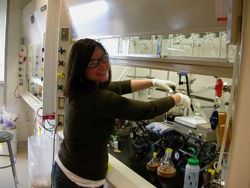
Alison Narayan is a fifth year organic chemist and organizer of the student-led green chemistry seminar at Berkeley (Photo: UC Berkeley)
NARAYAN: We’re working with these chemicals all the time but we don’t necessarily know how toxic they are. Or if they are toxic, like what their mode of action is, or why they are harmful to you.
LOBET: That’s Alison Narayan, another organizer of the student-run seminar series. Narayan is a fifth year organic chemist, making entirely new compounds.
NARAYAN: Really how we are trained is to focus on the reactivity of the chemicals and developing new reactions and new ways to build things, not necessarily even evaluating the performance of those materials or the toxicity of those materials.
LOBET: Narayan says she’s been surprised by the lack of toxicology training in her chemistry education. And environmental health scientist Michael Wilson says it seemed strange to him too.
WILSON: The fact is that in the United States you can earn a bachelor’s degree and a master’s degree and a PhD in chemistry at the universities and colleges across the United States and never demonstrate a basic understanding of how chemicals affect human health or the environment. And, so, are we surprised than toxic materials are finding their way into consumer products that are widely available on the market? We probably shouldn’t be.
LOBET: And Wilson says chemists aren’t the only scientists who have not paid much attention to toxicology. Amazingly, even public health experts often aren’t trained in it.
WILSON: So we are seeing a transformation in the school of public health embracing this idea of green chemistry, where, up to now, our job has really been about identifying, measuring characterizing the extent of the problem. It’s simply no longer possible for us in public and environmental health to clean the mess up at the end of the pipe. We have to design chemicals, we have to design products in ways they don’t show up in human blood, and in breast milk, and in hazardous waste sites, and in groundwater.
LOBET: The first big signs of changes taking place at Berkeley, besides the student-organized seminar, happened last summer. For the first time, the university offered its entry-level chemistry course with the option of a single lab section that was green.
[SOUND OF STUDENTS WORKING ON LAB BENCH]
LOBET: On this day, second-year students Swetha Akella and Michael Poon are doing a practice run through one of the new labs.

Second year students Michael Poon, Max Babicz and Swetha Akella help refine one of the new green lab experiments. (Photo: Ingrid Lobet)
POON: What she’s actually trying to do find the concentration of the dyes in the drinks to see how much we are consuming. Red 40 is very common in a lot of consumables. Because the amount of dye is very small, to get a measurable amount you have to boil off the water, and that increases the percentage of dyes in the sample. This is Sunkist and Hawaiian Punch.
AKELLA: I think the thing that really appeals to me is the practicality, because a lot of times you do a lab where you find, like, a concentration and you just like, forget about it afterwards. But when you do like, the sunscreen lab, or this lab, you really think about it the next time you put on sunscreen or the next time you decide to drink a soda.
LOBET: Poon points out, it’s not just a question of lab subject matter.
POON: I think it is a really important to think about where your actions are leading. If you pour something down a drain, where does it go? Think about that, and what needs to be done to process that to clean it up, to make it so that that water is usable again.
LOBET: A review of class evaluations from students who took that first green chemistry lab in the summer shows a lot of enthusiasm. Chantelle Khambholja was won of those freshmen.
KHAMBHOLJA: Well, our first lab section was on biofuels. And, in the first lab we went through and looked at the effects of biofuel on germination of seeds to measure ecotoxicity. In the second lab, we actually synthesized our own biodiesel, which was awesome, and in the third lab, we measured the amount of energy produced when it was burned.
LOBET: This fall term, the Berkeley Chemistry department converted all of the introductory lab sections into green chemistry labs. Berkeley chemistry lecturer Michelle Douskey oversees teaching assistants for the introductory classes. She says traditional chemistry curricula have been too focused on memorization. She’s trying to change that. The overlay of green chemistry, she says, will make content even more relevant for students who are already asking these questions.
DOUSKEY: The students are really curious about personal care products. What is in their water bottle? Is there lead in the paint in my really old apartment? And, all of these are chemistry problems.
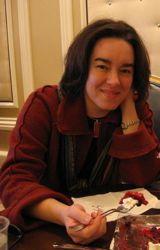
Dr. Michelle Douskey lectures in chemistry at Berkeley. (Photo: Scott Olson)
LOBET: A typical curriculum or text, Douskey says, might devote one problem to someone concerned about lead in drinking water, then move on to the next problem.
DOUSKEY: Maybe if we look at lead in paint, we might look at it from many different angles. We might revisit it throughout the semester. Is it going to stay in the paint or not? If it get’s in the dust then where does it go? Then there’s all of that chemistry stuff like how do I even detect for lead in paint? So that’s how we wrap in things like, well, light interacts with matter and we have certain instruments that help us to put some numbers on these things. So, I kind of feel like the green chemistry perspective is going to allow us to tell a more complete story. It was like we were telling part of a story before, you know, ‘oh well, you don’t need to know where this came from.’
LOBET: That idea, of teaching the whole story, has been central at the University of Oregon for more than a decade. As a leader in green chemistry, it’s taught two hundred chemistry faculty from around the country in annual week-long workshops. That gives U of O assistant department head Julie Haack a clear view of the changes at Berkeley.
HAACK: I think the changes that are happening at Berkeley are an incredible validation of this approach.
LOBET: A validation because of Berkeley’s heft and reach. Each year, 24 hundred incoming students will be learning their most basic chemistry principles …green.
HAACK: I think the impact is huge. These are the future decision makers in our society and what we’ve seen, once the students are armed with the tools of green chemistry, they really become empowered to participate in the solutions of finding more sustainable products and processes.
LOBET: If chemist Alison Narayan is any indication, the changes will be broad, from the mundane to the profound.
NARAYAN: So it does make me think about the way I do chemistry, for example reducing the amount of waste you have. We actually had a discussion last night in our research group meeting about reusing test tubes. So, we use lots of test tubes and then usually when we’re done with these, we just throw them away. So in my spare time when I am in my hood working up reactions, or on the bus on my way to lab, I find myself thinking about what else could you make that from? Instead of using this commodity chemical from petroleum, what else could you make that from? So it does, it does color the way I think about things and the type of daydreaming that I do.
LOBET: Berkeley has now opened a center for green chemistry. It’s planning a new graduate course in the spring. And it will be offer a new green chemistry emphasis that students may choose and that shows up like a minor on their transcripts. All these changes have not escaped the notice of the chemical industry, says Mike Wilson.
WILSON: These are discussions that strike at the very heart of the chemical enterprise, the things that we are writing about and the things that we are teaching have enormous influence for some of the largest industry groups and the largest companies in the world. And they certainly have an interest in influencing what we do here, and so we have had to be very careful, because we certainly want these companies to embrace the idea of green chemistry, not as a green wash, as a fundamental element of their corporate mission. But we also have to be independent in the way that we conduct our work, so there is an inherent tension there that we work with almost every day.
LOBET: That tension may be stronger at Berkeley, where the changes in chemistry teaching have implications for chemical policy across California. But the shift to green chemistry at universities around the country seems clear. Again, Julie Haack of the University of Oregon.
HAACK: Our goal is that green chemistry will just become the way chemistry is taught. And, pretty soon green chemistry will disappear and it will just become the way chemistry is done.
LOBET: At Berkeley professors say the goal is to turn out the next generation of not just chemists, but writers, politicians, and attorneys who can understand the consequences of the way things are made. For Living On Earth, I’m Ingrid Lobet.
Related links:
- Green Chemistry Education Network at U of O
- Database of curriculum material for educators GEMS -- Greener Education Materials
- Green Chemistry Community
- Warner Babcock Institute for Green Chemistry
- U Mass Center for Green Chemistry
- Yale Center for Green Chemistry
- Berkeley Center for Green Chemistry
- American Chemical Society Green Chemistry
- EPA Green Chemistry Education Site
[MUSIC: Stanton Moore “Green Chimneys” from All Kooked Out (Stanton Moore Music 2006)]
GELLERMAN: Coming up, spirits soar in the Big Apple on the wings of a Red-tailed Hawk called Pale Male. The bird of prey warms the hearts of New Yorkers and creates a community among strangers.
LILIEN: You would be sitting on the bench in the park, with Pale Male and his mate on this penthouse, and he would just go after pigeons, and catch it in mid-air right in front of you, and suddenly you have to share this.
GELLERMAN: The Legend of Pale Male and the man behind the legend is just ahead on Living on Earth.
[CUTAWAY MUSIC: The Youngbloods: “The Dolphin” from Ride The Wind (Warner Bros 1971).]
Lead Surprisingly Still in Brass Plumbing
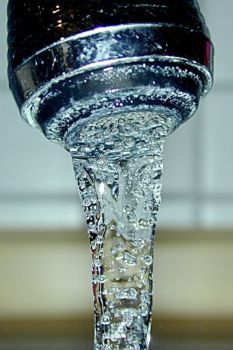
Brass plumbing is allowed to contain up to 8% lead. Researchers have found lead leaking into our drinking water. (Photo: Wikipedia Creative Commons)
GELLERMAN: It’s Living on Earth, I’m Bruce Gellerman. Officials at the University of North Carolina at Chapel Hill recently discovered something disturbing. The water coming out of dozens of brand new water coolers in their brand new building on campus had dangerously high levels of lead. It didn’t make sense. Lead’s a potent neurotoxin that was banned from pipes and solder used in plumbing decades ago. So where was the lead coming from? Marc Edwards, a professor of civil and environmental engineering at Virginia Tech, was called in to investigate. Professor Edwards, welcome to Living on Earth!
EDWARDS: Thank you for having me!
GELLERMAN: So, where was the lead coming from?
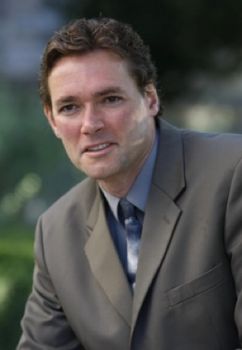
Virginia Tech Professor Marc Edwards. (Photo: Virginia Tech)
EDWARDS: Well, the only source of lead left in new construction has to do with brass fixtures. And these include your faucet at the kitchen and also intricate plumbing devices such as ball valves and water meters that are used on the path as the water flows to your tap.
GELLERMAN: Well, how did they discover the problem?
EDWARDS: Initially, some of the students and faculty in the building had complaints about the taste and odor of the drinking water. And, when they went to investigate, they were shocked to find that about 20% of the samples that they tested were over federal standards for lead.
GELLERMAN: Brass, if I’m not mistaken, is a combination of copper and zinc, right?
EDWARDS: Correct, but lead is added to improve that machine ability of the brass material. And, Congress in its wisdom, while it banned lead pipes and lead in solder, they chose under the safe drinking water act to define lead-free brass as anything that contains up to eight percent lead by weight. So, even to this day, it’s still perfectly legal to install brass that weights eight percent lead in brand new buildings.
GELLERMAN: So this lead was leaching out of the brass fitting?
EDWARDS: Uh, that’s correct. And, in some cases, the brass leach is much, much more than in others, depending on the device and the specific alloy.
GELLERMAN: So my guess- these water coolers weren’t the only ones to have this problem.
EDWARDS: Oh, by no means. We have sampled in several new schools around the country, and have found even in elementary schools, brand new buildings, a disturbing percentage of the lead collected from the taps over federal guidelines.
GELLERMAN: Oh, that’s trouble because kids are particularly susceptible to the neurotoxin lead.
EDWARDS: That’s correct, and that’s why this is such a concern.
GELLERMAN: So, what’s your guesstimate in terms of how wide spread this problem is?
EDWARDS: Well, we really don’t know because right now because no one is requiring testing. What makes the situation at UNC Chapel Hill so unusual is they had very conscientious administrators who adopted a zero-tolerance policy, and it’s only because of this policy that we detected this problem. In most cases people just assume that the water is safe.
GELLERMAN: Now these brass fittings, they met the federal standard.
EDWARDS: Yes, they did, and that’s what makes this so disconcerting. What we discovered that was on the surface, the contact with the water, we found lead levels as high as 18-20 percent by weight. So, it legally met the under-percent standard of the U.S. Congress, but, practically, it was as if these devices contained 18 to 20 percent lead.
GELLERMAN: So, lax standards, and lax inspections and oversight then.
EDWARDS: Well yes, there’s another standard, a performance standard, that these devices are supposed to pass that is designed to ensure that they should never leach lead at levels that constitute a health threat. But, about five years ago or so, we discovered that these tests, under the guides of the National Sanitation Foundation were so lax that it was akin to doing crash testing of cars into a wall of pillows. And, we showed that pure lead devices could pass their standard and so passing the tests meant nothing whatsoever in terms of how they actually perform. And so what we saw in UNC was a very clear and dramatic example of our earlier concerns that devices were being certified as safe when they were anything but.
GELLERMAN: So, in your expert opinion and experience, what needs to be done?
EDWARDS: Well, there’s currently a law sponsored by the Environment Public Works Committee of the U.S. Senate that will define lead-free as something far, far less than eight percent lead in the device that’s legally allowed. There’s discussion of only allowing zero point oh-two-five percent lead in surfaces that contact the water. And, if we had that standard, we would no longer have these problems. And, in a new building we could assume that the water is safe from elevated lead.
GELLERMAN: Just this past weekend, I put in a new faucet in one of my bathrooms, and should I be worried?
EDWARDS: Well, it’s quite common, that for a period of time, it could last anywhere from a week to a month or so, that the lead is elevated when you install a new faucet in your bathroom or kitchen. What made this most recent case so unusual is that the high lead persisted at levels 20, 30 times the federal standards for months and months and months. No matter how hard we tried to fix the problem, we couldn’t, until we went in and found this one particular device and eventually removed it.

Brass plumbing is allowed to contain up to 8% lead. Researchers have found lead leaking into our drinking water. (Photo: Wikipedia Creative Commons)
GELLERMAN: Well, what can I do, or what can anyone do at home if they have this problem- how can they even know that they have this problem?
EDWARDS: Well, that’s what makes it so difficult. It might only affect one out of a hundred or one out of a thousand taps with these very, very serious problems. But they’re extraordinarily difficult to remediate because once this plumbing is installed, of course it’s behind walls and in crawl spaces-- even knowing that the problem existed, it took us 30,000 dollars of staff time and effort to find this defective device and remove it form the system so it could no longer pose a danger to public health. So, I don’t have the answer right now, but the first step is to recognize that these problems can and do exist and we should be alert to them.
GELLERMAN: Well Professor Edwards, than you very much, I really appreciate it.
EDWARDS: You’re welcome.
GELLERMAN: Marc Edwards teaches at Virginia Tech. He and Carolyn Elfland from UNC Chapel Hill solved the mystery of the campus water coolers. Their findings are in the latest issue of The Journal of the American Water Works Association. And there’s a link to the study on our web site L-O-E dot org.
Related links:
- Read the article in the Journal of the American Water Works Association
- Visit Virginia Tech's Environmental and Water Resources Engineering Program—Marc Edwards’ department
The Legend of Pale Male

Pale Male flying over Fifth Avenue. (Photo: Courtesy of palemale.com)
GELLERMAN: This is a tale of two immigrants: One, a young man from Belgium, who decides to move to New York City in the early 1990s, seeking not fame nor fortune, but his fate. The other is a bird of prey -- a Red-tailed Hawk the likes of which hadn’t been seen in the city for a hundred years.
LILIEN: He was a Red-tailed Hawk, completely wild…a stranger to the city like I was, but he was no lost soul.

Filmmaker Frederic Lilien. (Photo: V. Herman)
GELLERMAN: Man and hawk both had high expectations. The hawk soon took up residence on a 12th floor window ledge of a Fifth Avenue apartment. For the man, moving up in the world was a bit slower. When Frederic Lilien and the bird’s paths crossed, both lives took a dramatic turn. The story of the Red-tailed Hawk known as Pale Male is documented in Frederic Lilien’s new feature-length film “The Legend of Pale Male: a hawk, a city, a love story.” Frederic Lilien, welcome to Living on Earth.
LILIEN: Thank you. Thank you for having me.
GELLERMAN: Why did you decide to come to New York City in the first place?
LILIEN: Huh. I guess I was out of options. I was in Belgium and, you know, failing in my law studies and decided to leave. And, my God, there’s no better place to go than New York City. And, I wrote a letter to my father saying that I would go for a few months and see for myself, and I eventually stayed fifteen years.

Pale Male spreading wings. (Credit: Courtesy of palemale.com)
GELLERMAN: So, you’re in Central Park and you stumble across this bird that’s soaring overhead and it changed your life.
LILIEN: It did. And, I must say at the time I was working as a floor manager of a hair salon on the Upper East Side, and, my God, it was hell on earth. I really hated that job. And, whenever I could escape I would go and eat my lunch in the park. And, one day, I just looked up and here he was eating his own lunch and I guess that day, I decided I would quit my job and buy a video camera and become a wildlife filmmaker.
GELLERMAN: You know, we should say that you might have been a better manager of a hair salon than you were a film maker.
LILIEN: Well, it took me quite a long time, but I guess sometimes in life you need those crazy moments to do something. It was probably a very old dream that was buried inside of me and being in New York helped.
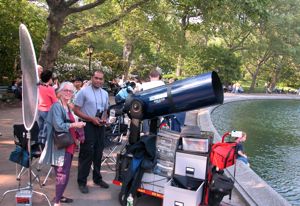
Lincoln Karim (in gray t-shirt) took many photographs and used a high-powered telescope, dubbed the Hubble, to watch Pale Male. (Photo: V. Herman)
GELLERMAN: Well, you know this city is a place of serendipity. You had a meeting with a guy named Charles Kennedy and he winds up changing your life.
LILIEN: Yes, absolutely. So, here I am with my little camera trying to run and find this hawk in this huge park, and I wasn’t very successful at it. And then one day I saw this guy with this huge camera, beautiful lens, 500mm lens, and of course my first reaction is “Oh my God, that guy, he’s stealing my idea!” And, he came to me with a big smile and it’s the kind of person that understood the whole picture here. And right away, he said, “What are you doing? Oh, well I have this lens if you want, you can borrow it.” And, oh my God, did I borrow it. I borrowed it for years and years and years. But most of all I should say we became very, very good friends.
GELLERMAN: I think we should say that he was watching this red-tailed hawk a lot longer than you.

Pale Male flying over Fifth Avenue. (Photo: Courtesy of palemale.com)
LILIEN: Absolutely. I mean, he was sort of an expert. He spent all his days in the park learning about all of the birds, the butterflies and the moth, and of course, Pale Male was his favorite. Because, that bird had something very special.
MAN 1: This bird is a pioneer. And, he has to make a rather magical accommodation. He has to adjust to humankind. But, if he does that, his reward is immense. There are pigeons here, there are rats, songbirds and squirrels. It is an amazing choice, and very rich, and all he has to do is get along with us.
GELLERMAN: He can get along fine with the people, but Pale Male takes up residency in one of the ritziest locales in New York City- on Fifth Avenue- and the question is, can we get along with him?
LILIEN: Uh, yes. Absolutely. I mean, he’s the first of his kind to come into the big city and decide: ‘I’m going to make it here.’ I guess like any other bird or any other animal, it’s all about survival. But this one did it with panache and everything, everything about this bird is just special and different- and what a story! I mean, the best script-writer in Hollywood could not come up with a story like this.
GELLERMAN: But this is a story not only about you and a hawk, it’s a story about a city, a community. It’s interesting because the city that you portray is one that strangers come together in a way that they ordinarily don’t.
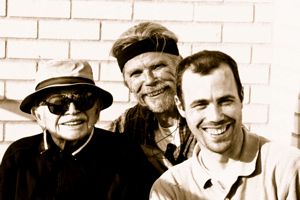
Dr. Alexander Fisher, Charles Kennedy, and Frederic Lilien, friends of Pale Male. (Photo: L. Stinchcomb)
LILIEN: Yes, and it’s probably the magic of Pale Male is because of him that people would sit on a bench. And, I believe in a way that observing nature, or living in nature, with nature, will make you a better person.
And, because you are admiring this magnificent free bird right in front of your eyes- and it’s quite spectacular- you would be sitting on the bench in the park, this beautiful setting, with Pale Male and his mate on this penthouse right in front of you and he would just go after pigeons and catch it in midair right in front of you. And, suddenly you have to share this with the person on your left or the person on your right. And, one is a billionaire living on the building right next to Pale Male and the other one is a homeless.
WOMAN 1: I have a cockatiel that’s living in the window on the 9th floor between Madison and Park Avenue. And, all of a sudden, I hear my bird go crazy and I see this huge hawk on my windowsill. I took the bird on my fingers to calm it down and it didn’t die, but I think he might have had a shock!
WOMAN 2: It’s almost like seeing the Virgin Mary in a tree or something, you know. I mean, why do people go to see something that’s an image of…It’s almost religious in a way that I come and see him now.

Pale Male with a stick. (Credit: Courtesy of palemale.com)
MAN 2: Some people go to Mecca, some people go to Jerusalem, but I just have to go to the Madison Avenue bus and I get to see Pale Male.
MAN 3: To see a father hawk, or a mother hawk bring a rat to his baby- it’s wonderful- it’s biblical!
GELLERMAN: These are real New York characters, right out of central casting!
LILIEN: Oh, yes, New Yorkers are the best. (Laughs). They are amazing. I mean to me… and I guess I understood that after a few years of trying, what I was trying to do that the story wasn’t necessarily up there in the nest, but was right here on the bench. And, Pale Male had become this fantastic way to explore what nature could do to us, and how people perceive it.

Pale Male lands on his nest. (Credit: Courtesy of palemale.com)
GELLERMAN: Is Pale Male still sitting atop 927 on Fifth Avenue?
LILIEN: He’s still there, he’s still there. He’s still doing it. He doesn’t give up. He will not give up, as you know, as any good New Yorker, they’re very resilient.
GELLERMAN: If you can make it there, you can make it anywhere!
LILIEN: Absolutely. So, he’s not giving up. I mean, he’s had, you know, issues since the nest was removed in 2004, but they’re not giving up. Pale Male and his mate Lola are still around. If you come to New York City, go to Central Park and you’ll probably find him flying overhead or catching a pigeon right in front of you!
GELLERMAN: Well Frederic Lilien, thank you very much, I really appreciate it.
LILIEN: Sure, my pleasure.
GELLERMAN: Frederic Lilien’s feature film, “The Ledged of Pale Male” will open at the Angelica Theater in New York City at the end of this month, and then in selected theaters around the country beginning in December.
[HAWK CRY]
Related links:
- “The Legend of Pale Male”
- Lincoln Karim’s photos of Pale Male
- The late Charles Kennedy’s blog
[MUSIC: Andrew Bird “Carrion Suite” from Useless Creatures (Fat Possum Records 2010).]
GELLERMAN: We leave you this week in Iona Island at Stony Point, New York.
[SFX - CD “A Sound Map of the Hudson River”, Annea Lockwood, Lovely Music, Ltd © 1989 and 2003, Track 13.]
GELLERMAN: The Island is one of four tidal wetlands located along the Hudson River Estuary. The U.S Navy used it to store bullets and bombs until the end of World War II. Today, Iona and the adjacent Salisbury Marsh, is home to 165 species of birds and it’s a spawning area for fish. Annea Lockwood followed the Hudson River from the Adirondacks down to the Atlantic. She recorded the ebbs and flows for a CD she calls “A Sound Map of the Hudson River.”
[SOUNDS OF THE HUDSON RIVER]
GELLERMAN: Living on Earth is produced by the World Media Foundation. Our crew includes Bobby Bascomb, Eileen Bolinsky, Ingrid Lobet, Helen Palmer, Jessica Ilyse Smith, Ike Sriskandarajah, Mitra Taj, and Jeff Young, with help from Sarah Calkins, Sammy Sousa, and Emily Guerin. Our interns are Nora Doyle-Burr and Honah Liles. Jeff Turton is our technical director. Alison Lirish Dean composed our themes. You can find us anytime at L-O-E dot org – and while you’re online, check out our sister program, Planet Harmony. Planet Harmony welcomes all and pays special attention to stories affecting communities of color. Log on and join the discussion at My Planet Harmony dot com. And, don’t forget to check out our Facebook page, PRI’s Living on Earth. Steve Curwood is Living on Earth’s executive producer. I’m Bruce Gellerman. Thanks for listening.
ANNOUNCER: Funding for Living On Earth comes from the National Science Foundation supporting coverage of emerging science. And Stonyfield farm, organic yogurt and smoothies. Stonyfield pays its farmers not to use artificial growth hormones on their cows. Details at Stonyfield dot com. Support also comes from you, our listeners. The Ford Foundation, The Town Creek Foundation, The Oak Foundation—supporting coverage of climate change and marine issues. The Bill and Melinda Gates foundation, dedicated to the idea that all people deserve the chance at a healthy and productive life. Information at Gates foundation dot org. And Pax World Mutual Funds, integrating environmental, social, and governance factors into investment analysis and decision making. On the web at Pax world dot com. Pax World for tomorrow.
ANNOUNCER 2: PRI – Public Radio International
Living on Earth wants to hear from you!
Living on Earth
62 Calef Highway, Suite 212
Lee, NH 03861
Telephone: 617-287-4121
E-mail: comments@loe.org
Newsletter [Click here]
Donate to Living on Earth!
Living on Earth is an independent media program and relies entirely on contributions from listeners and institutions supporting public service. Please donate now to preserve an independent environmental voice.
NewsletterLiving on Earth offers a weekly delivery of the show's rundown to your mailbox. Sign up for our newsletter today!
 Sailors For The Sea: Be the change you want to sea.
Sailors For The Sea: Be the change you want to sea.
 The Grantham Foundation for the Protection of the Environment: Committed to protecting and improving the health of the global environment.
The Grantham Foundation for the Protection of the Environment: Committed to protecting and improving the health of the global environment.
 Contribute to Living on Earth and receive, as our gift to you, an archival print of one of Mark Seth Lender's extraordinary wildlife photographs. Follow the link to see Mark's current collection of photographs.
Contribute to Living on Earth and receive, as our gift to you, an archival print of one of Mark Seth Lender's extraordinary wildlife photographs. Follow the link to see Mark's current collection of photographs.
 Buy a signed copy of Mark Seth Lender's book Smeagull the Seagull & support Living on Earth
Buy a signed copy of Mark Seth Lender's book Smeagull the Seagull & support Living on Earth

